Czichos H., Saito T., Smith L.E. (Eds.) Handbook of Metrology and Testing
Подождите немного. Документ загружается.

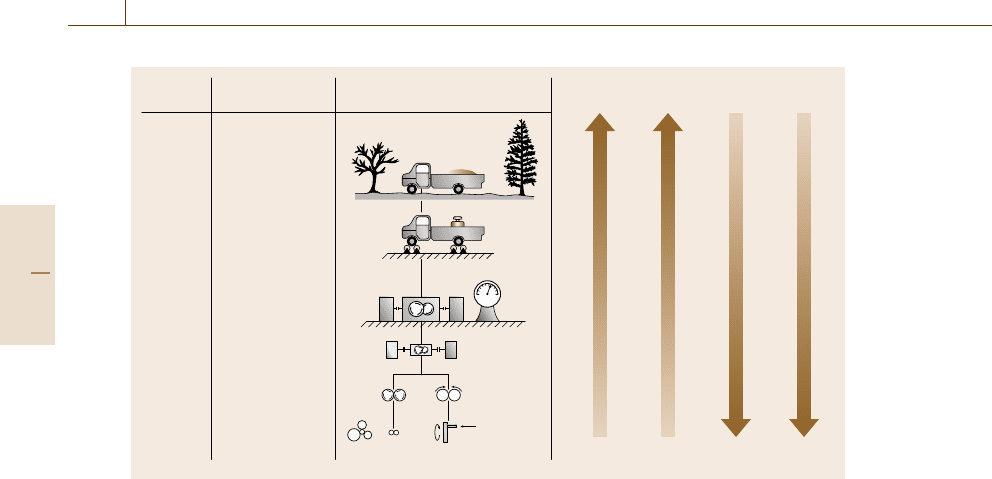
748 Part D Materials Performance Testing
Category Type of tests
Machinery
field tests
Machinery
bench tests
Systems
bench tests
Components
bench tests
Model tests
Laboratory tests
Symbol
Increasing
cost
Increasing
complexity
Increasing
control
Increasing
flexibility
II
III
IV
V
I
VI
Fig. 13.4
Schematic illus-
tration of types
of tribological
test (after [13.3])
the tribological performance of materials when they are
being developed or selected for a general field of ap-
plication, but when the specific conditions that will be
applied are not well-defined. In this case there is little
information to guide the specification of the test param-
eters to be used in any test program, and indeed the
specific test that should be used is not always clear.
However, it is important to consider carefully how the
materials will be used in order to eliminate inappropri-
ate tests that will only lead to misleading results. Thus,
for materials that are being developed for applications
where abrasion is extremely likely to occur, sliding wear
tests cannot be expected to give relevant data. Neverthe-
less, so long as the likely mode of wear can be predicted,
useful information can be obtained on the likely perfor-
mance of the materials in practice.
The second situation is where there is a requirement
to simulate a specific application. Here the conditions
that are operating in the tribological contact should be
better defined, so that the design of a program of lab-
oratory wear tests reduces to choosing the appropriate
test and test parameters to achieve the correct simulation
of the practical application. Although in some cases the
best approach is to design and manufacture a specific
rig that is intended to reproduce the conditions in the
application precisely, in most cases a well-established
test can be used, perhaps with some adjustment of the
test parameters, to provide a reasonable match with the
application. The selection of these parameters is the key
to generating a valid test.
As it is often difficult to achieve an exact simulation
in the laboratory, it is always important to check that
the same mechanisms of wear occur in the laboratory
test as in the real application. When this is achieved,
the laboratory test is likely to give results that will reli-
ably predict performance in the application. Figure 13.5
shows an example of such a comparison, from tests per-
formed to simulate the abrasion of cemented carbide
extrusion tools used to form ceramic roof tiles. The fea-
tures of the worn surfaces of the cermets were very
similar in both laboratory tests and the samples recov-
ered from the practical application, and subsequent field
trials showed an excellent match between the results of
the laboratory tests and the lifetimes of the components
in service.
13.2.2 Test Parameters
Many parameters control and define the conditions in
a tribological contact, and hence influence the result-
ing wear and friction. Important examples are listed
in Table 13.1. Some of these parameters are only appli-
cable to specific types of wear; for example the shapes
of abrasive or erodent particles are relevant only to the
processes of abrasion or erosion.
A full description of the effects of these test pa-
rameters is well beyond the scope of this chapter. The
reader should refer to other sources for a fuller descrip-
tion [13.4, 5], but some aspects are discussed briefly
here.
Part D 13.2
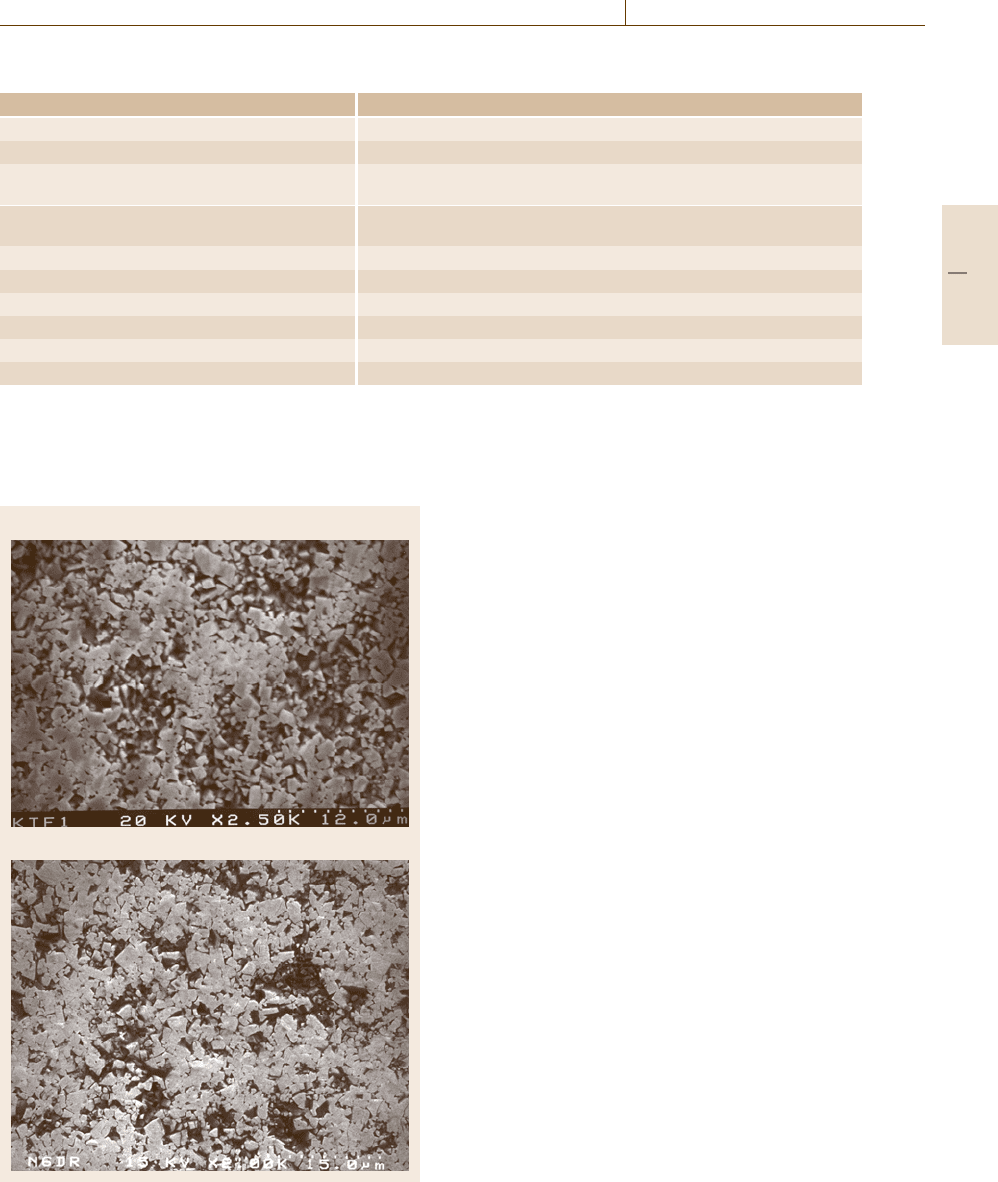
Friction and Wear 13.2 Selection of Friction and Wear Tests 749
Table 13.1 List of some important parameters that influence tribological processes
Parameter Units or type of information
Normal load N
Sliding speed m/s
Materials of triboelements All aspects of composition and microstructure, at surface as well as sub-
surface
Test environment (including any lubricant present) Composition, chemical and physical properties of gas and/or liquid sur-
rounding tribological contact
Temperature
◦
C
Type of relative motion between surfaces Trajectory: sliding, rolling, impact etc.
Contact geometry (form) Shapes of surfaces
Contact geometry (local) Roughnesses of surfaces
Abrasive/erosive particles Material, shape (and distribution), size (and distribution)
Contact dynamics Stiffness, damping, inertial mass
In laboratory testing it is normal to positively con-
trol only a few test parameters such as the applied
normal load, relative speed and contact geometry. Other
a)
b)
parameters that can have a major effect on the resulting
wear and friction are the presence of lubrication, the en-
vironment and atmosphere of the test (including the air
humidity), the bulk temperature of the samples, and the
mechanical dynamics of the test system. These parame-
ters are normally held constant from one test to another,
either by the application of a specific control method-
ology, or simply by using the same test system for the
whole sequence of tests in the program.
The contact geometry is a crucial parameter in the
design of a wear test where two bulk surfaces are in
moving contact, as in sliding. The ideal situation, in
which the nominal contact area, and hence nominal con-
tact pressure, would not vary during the test, would be to
achieve self-aligning conformal contact between the test
samples. This can be achieved in some cases by careful
design of the samples and their holders, but often it can-
not be achieved, and then high initial contact stresses
occur at the edges of the misaligned contacts. To avoid
this uncontrolled nonconformal geometry, it is common
to use a controlled nonconformal geometry with one tri-
boelement in the form of a ball or spherically-ended
pin loaded against a flat sample. A ball diameter of
about 10 mm is typically used. The disadvantage of this
approach is that although the initial contact geometry
is well controlled, the initial contact stresses are high.
The ball or pin then wears rapidly until a larger con-
tact area is produced, resulting in a substantially lower
contact pressure. This change may lead to a change in
Fig. 13.5a,b Example of comparison of worn surfaces
from a laboratory simulation and a practical application.
The SEM images show WC/Co tools used to manufac-
ture concrete tiles: (a) worn surface from production tool;
(b) worn surface of sample after laboratory wear testing
Part D 13.2

750 Part D Materials Performance Testing
wear mechanism from the initial high-stress regime to
a subsequent low-stress, larger contact area regime. An
approach that reduces this effect is to use one triboele-
ment with a large contact radius so that although the
initial contact geometry is still well defined, the initial
contact pressure is lower, and changes in mechanism are
less likely.
The temperatures of the contacting triboelements
can affect the tribological behavior through changes in
their mechanical and chemical properties. As well as
these bulk effects, the areas of the samples in contact
become hotter through frictional heating; the power dis-
sipated in the contact is given by μNv where μ is the
friction coefficient, N is the normal load, and v is the
relative sliding velocity. The local temperatures at the
contact areas can therefore become much higher than
the bulk temperatures [13.6]. This factor needs to be
taken into account when designing wear tests or inter-
preting test results.
As outlined in Sect. 13.1.3, lubrication of the con-
tacts will also affect the wear, often in terms of
mechanism as well as amount. Under certain condi-
tions of sliding speed, load and lubricant viscosity,
the two surfaces become separated by a continuous,
hydrodynamically-generated lubricant film, and the
wear rate can fall to a very low level, as indicated
in Fig. 13.3. Hydrodynamic lubrication (a thick lubri-
cant film) is favored by low normal pressure, high
lubricant viscosity, and high sliding speed. For con-
ditions where the lubricant film thickness becomes
comparable with the roughness of the triboelements,
elastic deformation of these bodies becomes important
and the pressure in the lubricant is high enough to
cause a significant local increase in viscosity; this is
the regime of elastohydrodynamic lubrication (EHL).
For even thinner films (at low speeds or high contact
pressure), the system enters the regime of boundary lu-
brication, where appreciable interaction occurs between
asperities on the two surfaces. Here the chemical com-
position of the lubricant has a major effect on the nature
and properties of the chemically formed surface films
and on the wear that occurs.
13.2.3 Interaction with Other Degradation
Mechanisms
Other degradation mechanisms such as chemical reac-
tion and fatigue can also make a major contribution to
the overall loss of material from moving contacting sur-
faces. Interactions often occur with the test environment
through chemical reactions of the test materials. In wear
corrosion, the triboelements are exposed to an aqueous
medium, and corrosion of the materials acts in conjunc-
tion with mechanical processes to alter the amount of
material lost. There is positive synergy in most cases,
so that the mass loss is greater than the sum of the con-
tributions expected from pure corrosion or pure wear
alone. Exceptionally, in negative synergy, corrosion can
form a mechanically stronger layer on the surface which
acts to protect the surface and thus reduce the total wear
rate. Tribochemical reactions of materials may also oc-
cur; ceramics, for example, can react with water vapor
to form hydroxides that reduce friction and protect the
wearing surface.
When metals are heated, either through a bulk
increase in temperature or by frictional heating, con-
siderable oxidation can occur. At first this may reduce
wear, as seen in the mild wear of steels, but as the
temperature increases further, the production of weak
oxide may increase to such an extent that the wear rate
increases once more [13.4].
In many tribological systems, the surfaces of
the contacting materials are subjected to alternating
stresses. These stresses may be high enough to initi-
ate and grow fatigue cracks in the material that may
contribute to the material loss caused by other wear
processes. Rolling contact fatigue is an important degra-
dation mechanism in certain applications of materials,
but lies outside the scope of this chapter.
13.2.4 Experimental Planning
and Presentation of Results
When planning a program of tribological tests, the
choice of test conditions must be determined, either
by the relevant engineering application, or in order to
achieve the appropriate mechanism of wear in more
fundamental studies. In the development of materials,
a range of conditions can be chosen to represent those
likely to occur during actual use of the material.
There are many test factors that need to be con-
trolled during a test. These can be grouped into those
concerned with the mechanical test conditions (such
as contact load or pressure, speed, motion type and
test environment), and sample parameters (such as
material composition, microstructure and the initial
surface finish of the samples). A full program of test-
ing under all combinations of these factors would be
time-consuming and costly, and may not be required.
Often a single factor can be identified as key to the
material response, and in this case a good approach
is to set all the other factors at constant values and
Part D 13.2
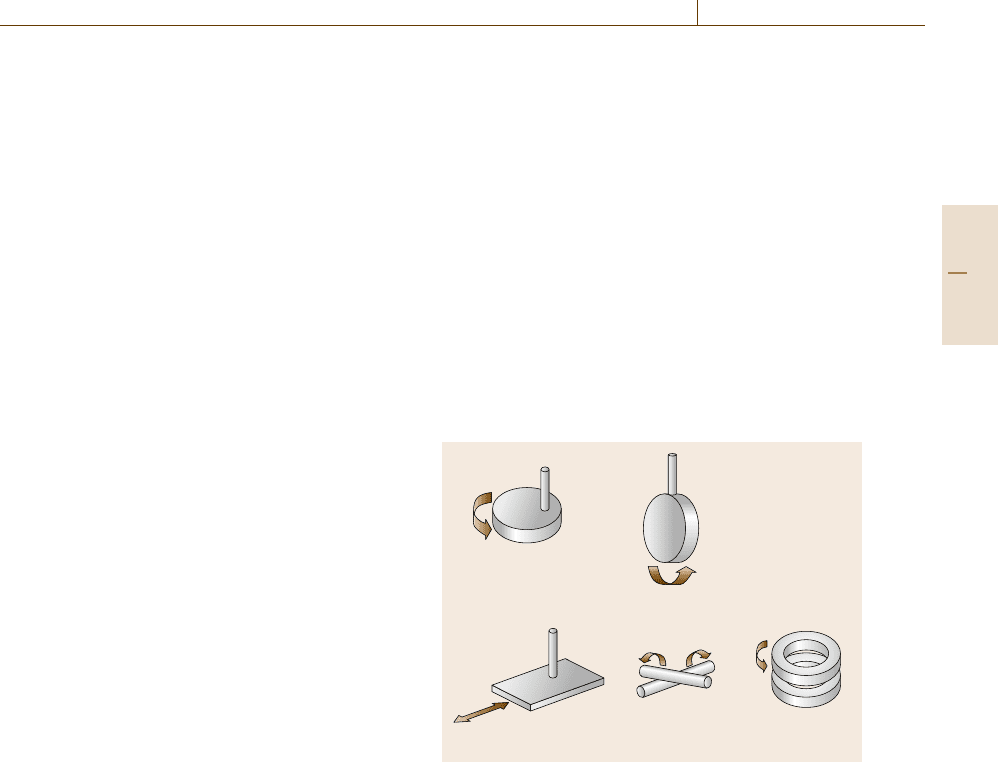
Friction and Wear 13.3 Tribological Test Methods 751
vary the chosen factor in a controlled way in a se-
ries of tests. This approach is termed a parametric
study. More complex statistical, experimental design
procedures can be used, but care needs to be taken
in the design of experiments to account for the vari-
ability that is normally observed in the results of wear
tests.
Mapping techniques can be used where two (or
more) factors are changed in a controlled way (normally
more coarsely than in parametric studies), with the fric-
tion and wear results plotted either as individual points
or as contours. Regions on the map are then delin-
eated on a mechanistic basis, with the region boundaries
either defined by identifying the wear mechanism by
microstructural techniques, or by identifying transitions
in friction and wear behavior as sudden changes in wear
rate or friction coefficient. The mapping procedure is
a very efficient way of determining the overall behav-
ior of a material because it provides useful information
about the position of transitions in wear behavior in
a systematic and controlled way. This comes at the ex-
pense of a reduction in the detailed knowledge of the
variation of friction and wear with any one factor, but
once the regime of interest is better defined through the
use of mapping studies, then a more detailed parametric
study can be conducted.
13.3 Tribological Test Methods
This section gives some information on the tribologi-
cal tests that are in common usage, and which have in
many cases been standardized, particularly through the
American Society for Testing and Materials (ASTM).
Due to constraints on space, only a brief description
can be given. Further information can be obtained from
other sources [13.5, 7–12]. The main test parameters,
the measurements that can be made, and the standards
associated with each type of test are listed.
13.3.1 Sliding Motion
Wear tests for materials in sliding contact are character-
ized by continuous contact between the two samples in
tribological contact. There are two distinctly different
types of test.
In many tests, the extent of relative movement is suf-
ficiently large (typically greater than 300 μm) so that all
contact points on at least one of the bodies are out of
contact for some of the test period. This is in contrast
to the case of fretting, where at least part of the contact
area on both samples is always in contact. In fretting
tests, the debris is trapped at the interface between the
two samples, leading to different behavior from that in
tests involving larger extents of movement, in which the
debris is more readily lost from the contact region.
Common tribological test geometries involving slid-
ing motion are shown in Fig. 13.6. Pin-on-disc and
reciprocating geometries are used most often, but pin-
on-disc testing with continuous rotary motion is often
not appropriate since many applications involve recipro-
cating motion. This difference is important, as it affects
the retention of debris at the wear interface and the
stress history on the surfaces. Fretting tests are always
Pin on disc Pin on ring
Pin on flat Crossed cylinder Thrust washer
Fig. 13.6 Examples of test geometries used for tribological
tests involving sliding motion
carried out with a reciprocating geometry; particular
care is needed in apparatus design as the elastic defor-
mation of the test system can be similar in magnitude
to the required sample motion, leading to difficulties
controlling and measuring sample displacement.
Often balls are used instead of pins, and in some
cases blocks (with large contact areas) are also used.
The choice of a conformal or nonconformal contact ge-
ometry and the frictional generation of heat are factors
that need to be carefully considered.
13.3.2 Rolling Motion
Tribological contacts often involve rolling motion. Suit-
able test geometries are shown in Fig. 13.7.Ifthe
application is concerned with bearing races, then this is
Part D 13.3
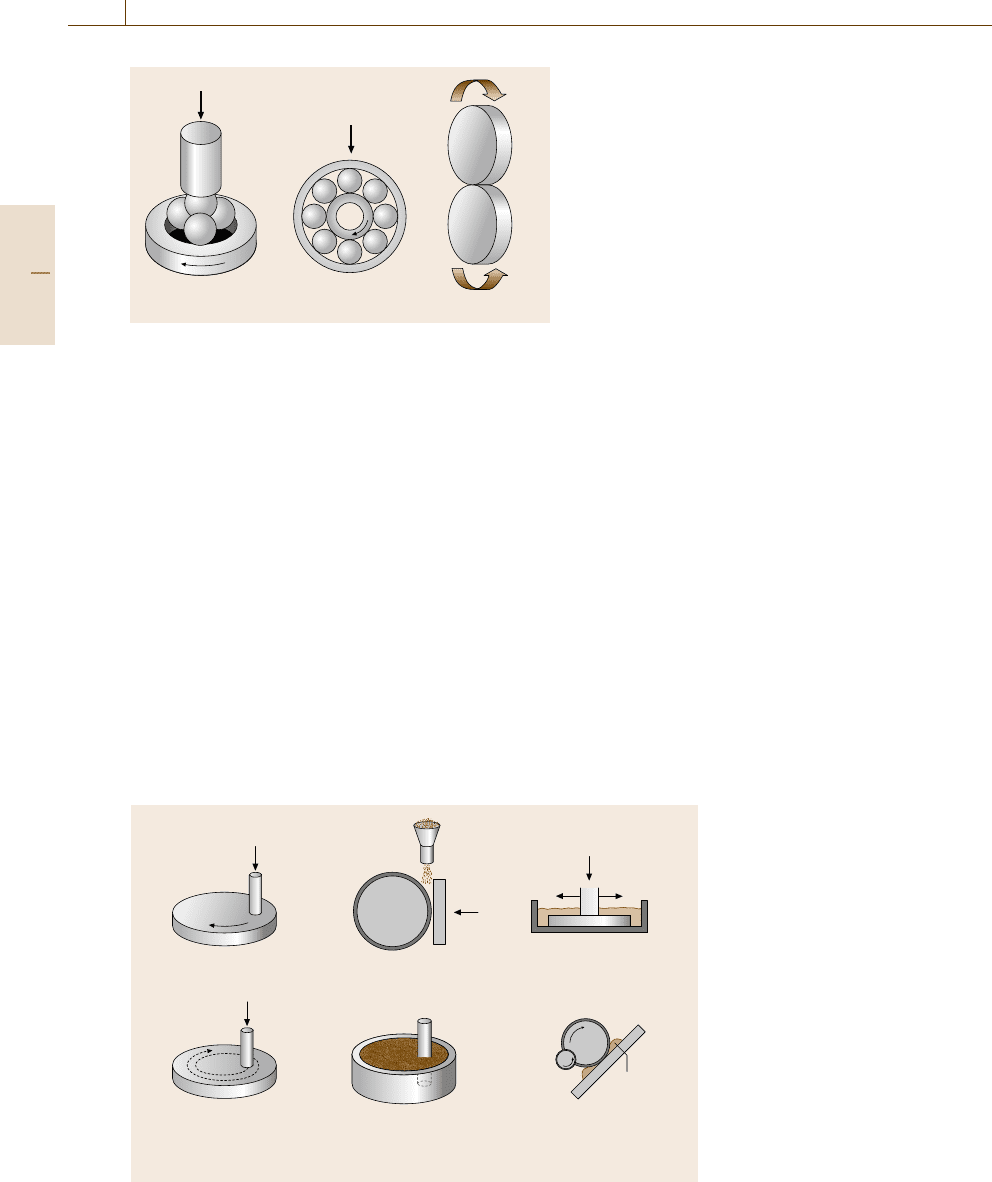
752 Part D Materials Performance Testing
Four ball test Balls in bearing race
F
F
Roller on roller
Fig. 13.7 Examples of test geometries used for tribological
tests involving rolling motion
one situation where laboratory tests can be carried out
relatively easily on the components themselves. This is
clearly appropriate for roller bearing applications, but
the complexity of the test geometry means that it is of-
ten difficult to develop a fundamental understanding of
the wear and friction processes that occur.
The four-ball test has been popularly used for many
years to test, in particular, the maximum load and speed
for failure at the contact points in this test geometry,
from mechanisms such as scuffing and seizure. How-
ever, results from this test, which can involve very high
contact pressures and frictional power dissipation, are
not readily extended to practical applications, and the
method also suffers from a lack of control of the detailed
motion of the balls during the test.
In two-roller testing, on the other hand, there is in-
dependent control of the motion of the rollers, and it is
possible to adjust the amount of relative sliding between
Pin on rotating
abrasive disc
Plate against rotating
wheel with feed of abrasive
Block on a moving plate
in a bath of slurry
Pin on rotating abrasive
disc with spiral track
Wear of pin in rotating
pot of slurry
Micro-scale abrasion test
with rotating ball on plate
in presence of abrasive
Drive shaft
Abrasive
slurry
F
F
F
F
Fig. 13.8 Examples of test geometries
involving abrasion
them as well as the rolling speed. The cylindrical edge
of the rollers sometimes has a flat cross-section, but is
also commonly crowned.
13.3.3 Abrasion
Abrasion testing can be carried out with a range of tests,
asshowninFig.13.8. The simplest type of testing is car-
ried out by loading a sample pin against abrasive-coated
paper supported on a solid backing. As well as using
a rotating abrasive-covered disc, tests can also be car-
ried out with abrasive paper held on to a drum, or with
a belt of abrasive paper. An important issue with these
tests is that, as abrasion of the test sample takes place,
the abrasive paper degrades by clogging with wear de-
bris and due to damage to the contacting regions of the
abrasive particles, so that the wear of the test sample
will typically decrease as the test progresses; in extreme
cases the wear mechanism may change as sliding then
occurs predominantly against debris rather than against
the abrasive particles. The use of a spiral track on the
abrasive paper can achieve a steady process of wear by
ensuring abrasion against fresh particles.
In another common type of abrasion test, a sam-
ple is pressed against a rotating wheel in the presence
of a continuous supply of free abrasive particles. An
important parameter in these tests is the stiffness of
the wheel or other counterbody. Tests can also be car-
ried out dry or in fluids of different types, allowing
tests to be made in the presence of corrosive media.
Some tests with rotating wheels involve the recir-
culation of abrasive during a single test (ASTM B
611 [13.8]), while in others a continuous stream of
Part D 13.3
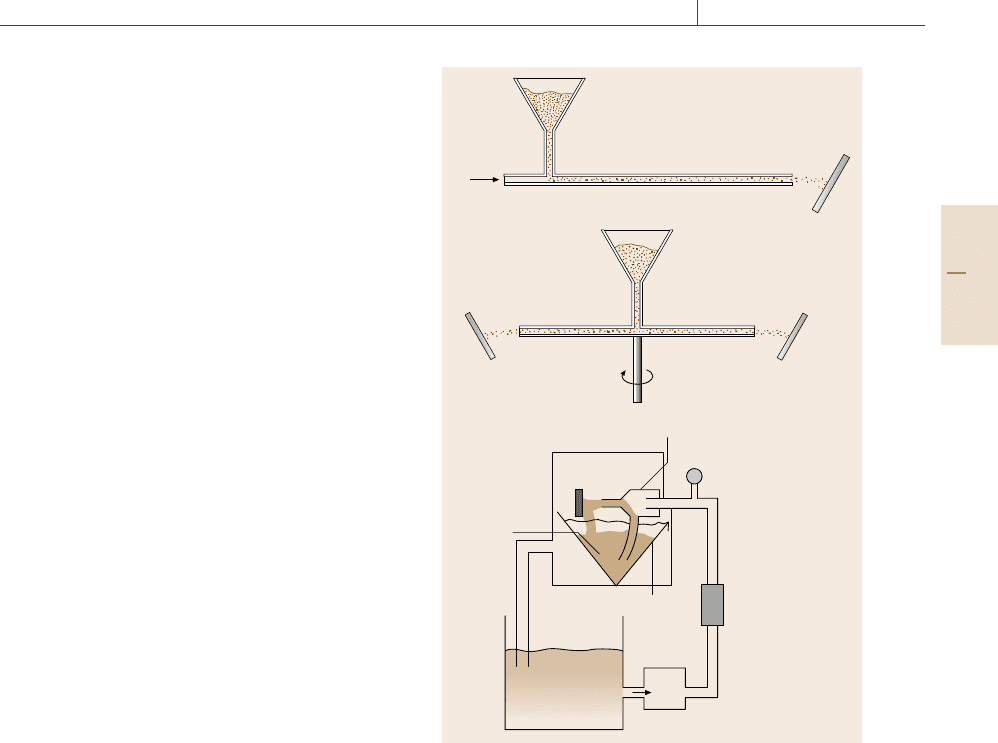
Friction and Wear 13.3 Tribological Test Methods 753
abrasive passes through the wear interface and is not
reused (such as the dry sand rubber wheel abrasion test,
ASTM G 65 [13.8]).
A test that has received some prominence recently
is the microscale abrasion test, in which a ball is rotated
against a flat sample in the presence of abrasive. This
test is particularly suited to determining the abrasion
rateofacoating.
13.3.4 Erosion by Solid Particles
There are two main groups of particulate erosion tests,
in which the particles either strike the sample in a gas
(usually air), or are transported in a liquid, which is
usually termed slurry erosion. Examples are shown
in Fig. 13.9.
In the centrifugal accelerator, the erodent particles
are accelerated along radial tubes in a rotor so that
a stream of erodent particles emerges at some angle to
the rotor periphery (which depends on the detailed de-
sign) to strike one or more samples located in a ring
around the rotor. This test has the advantage that several
different samples can be tested simultaneously, but there
is usually some uncertainty in the angle with which
the particles strike the samples, and only a fraction of
the particles fed into the apparatus actually strike the
samples. Some designs of centrifugal accelerator impart
significant rotation to the particles, which may influence
the resulting erosion rate. In the gas-blast test a com-
pressed gas stream (usually air) accelerates the erodent
particles along a nozzle towards the sample, which is
held at a controlled angle to the stream. In this case only
one sample can be tested at a time.
In slurry erosion testing a pump can be used to gen-
erate liquid flow through a nozzle. Erodent particles are
incorporated into the jet, being either picked up through
a venturi system or suspended in the erodent slurry. The
resulting jet of slurry is directed against the test sample
held at a controlled angle.
In all erosion tests the particle impact speed and the
angle of impingement of the erodent stream against the
sample are the most important variables.
13.3.5 Scratch Testing
Scratch testing was originally developed to evaluate the
adhesion of coatings. In the scratch test an indenter of
well-defined geometry is pressed onto and moves rel-
ative to a sample under a fixed or increasing normal
load. The tangential force resisting the motion (usually
described as the friction force) and acoustic emission
Gas in
a)
b)
c)
Test chamber
Funnel
Flow
gauge
Pump
Test
solution
Specimen
Sand bed
Ejector
Pressure
gauge
Fig. 13.9a–c Examples of tests involving erosion by solid
particles: (a) gas-blast test; (b) centrifugal accelerator;
(c) fluid jet rig
from the sample are often both measured continually.
The acoustic emission signal typically increases sharply
when a brittle coating is cracked, or the coating delam-
inates from the substrate.
When the test was developed, the adhesion of typi-
cal engineering coatings was quite poor and the scratch
test provided reasonable results, representative of the
adhesion of the coating. More recent coatings are much
more adherent, and although the scratch test remains an
extremely valuable test for coatings, the results are more
difficult to interpret, giving information on the complex
response of the coating–substrate composite system to
the movement of the indenter.
In the context of wear testing, scratch testing can be
used as a model abrasion test; the response of a ma-
terial to the scratching of the indenter is treated as
Part D 13.3

754 Part D Materials Performance Testing
an analog of its response to a hard asperity or abra-
sive particle. Parameters such as the frictional force
generated and the scratch width can be measured.
Multiple scratches can be made both in the same po-
sition or intersecting one another to extend the model
range.
13.4 Friction Measurement
As discussed in Sect. 13.1.1, the measurement of fric-
tion involves the measurement of the friction force.
For a rotating component it may be useful to define
the friction torque, the measurement of which also in-
volves a force measurement combined with a length
measurement.
13.4.1 Friction Force Measurement
A friction force measurement system is made up of one
or more force transducers mounted between one of the
triboelements and the base frame of the tribometer, and
their associated instrumentation. A practical force trans-
ducer usually consists of a chain of several transducers.
For example, the force may act upon and bend a metal
beam, and the bending then alters the electrical resis-
tance of a strain gauge bonded to the surface of the
beam by an amount proportional to the force. For many
types of force measurement system, the term load cell
is commonly used in place of force transducer.
Most force transducers employ some type of elas-
tic load-bearing element or combination of elements.
Application of force to the elastic element causes it
to deflect, and this deflection is then sensed by a sec-
ondary transducer which converts it to an output. The
output may be in the form of an electrical signal (as
from a strain gauge or LVDT, a linear variable differ-
ential transformer), or a mechanical indication (as in
proving rings and spring balances). However, the most
common method is for longitudinal and lateral strains
to be sensed, and when this is done by electrical resis-
tance strain gauges the transducer is known as a strain
gauge load cell.
13.4.2 Strain Gauge Load Cells
and Instrumentation
A strain gauge load cell is based on an elastic ele-
ment to which a number of electrical resistance gauges
are bonded. The geometric shape and elastic modulus
of the element determines the magnitude and distri-
bution of the strain field produced by the force to
be measured. Each strain gauge responds to the lo-
cal strain at its location, and the measurement of force
is determined from the combination of these individ-
ual measurements of strain. Each elastic element is
designed to measure the force acting in a particular di-
rection, and not to be affected by other components
such as side loads. The material used for the elastic ele-
ments is usually tool steel, stainless steel, aluminum or
beryllium–copper. The material should exhibit a linear
relationship between the stress (proportional to the force
applied) and the strain (output), with low hysteresis and
creep in the working range. A further requirement is
a high repeatability between force cycles, with no fa-
tigue effects.
The most common materials used for strain
gauges are copper–nickel, nickel–chromium, nickel–
chromium–molybdenum and platinum–tungsten alloys.
The foil strain gauge is the most widely-used type be-
cause it has significant advantages over the other types
and is employed in the majority of precision load cells.
A foil strain gauge consists of a metal foil pattern sup-
ported on an electrically insulating backing of epoxy,
polyimide and glass-reinforced epoxy phenolic resin.
It is constructed by bonding a sheet of thin rolled
metal foil, 2–5 μm thick, on a backing sheet 10–30 μm
thick. The measuring grid pattern including the terminal
tabs is produced by photoetching, in a process sim-
ilar to that used in the production of printed circuit
boards.
Semiconductor strain gauges are manufactured from
n-type or p-type silicon. The output from a semiconduc-
tor gauge is about 40 to 50 times greater than that from
a metal foil gauge. While the output is not linear with
strain, they do exhibit essentially no creep or hystere-
sis and have an extremely long fatigue life. Because of
their high temperature sensitivity, careful matching of
the gauges and a high level of temperature compensa-
tion is required.
Thin film strain gauges are produced by sputtering
or evaporation of thin films of metals onto an elastic
element. Wire strain gauges are used mainly for high-
temperature transducers. The wire is typically 20 to
30 μm in diameter and is bonded to the elastic element
with ceramic material.
The rated capacities of strain gauge load cells range
from 0.1 N to 50 MN, at a typical total uncertainty of
Part D 13.4
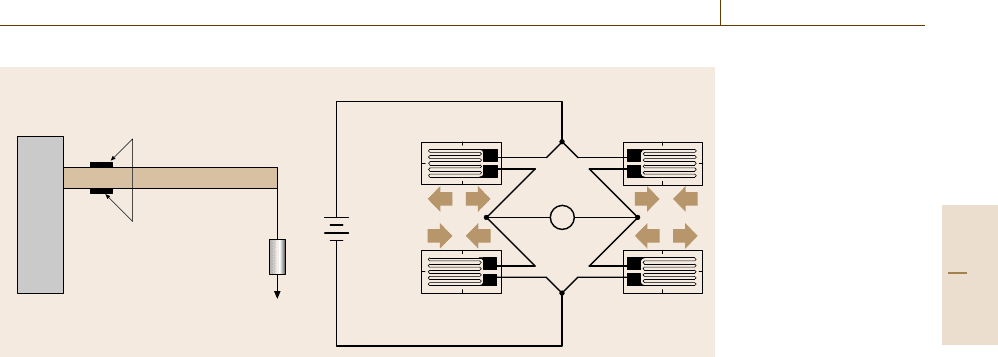
Friction and Wear 13.4 Friction Measurement 755
V
Cantilever beam
Fixation
1 or 2 strain gauges
(on top and/or bottom)
Strain gauge
(stressed)
Strain gauge
(stressed)
Strain gauge
(stressed)
Strain gauge
(stressed)
Full-bridge strain gauge circuit
F
Fig. 13.10
Example of
strain gauges
connected into
a full-bridge
circuit
0.02–1% of full scale. The range of capacity depends
on the type of gauges, with thin film gauges having
the highest sensitivity (typically 0.1–100 N), followed
by semiconductor gauges (1 N–10 kN), and foil gauges
(5–50 MN).
The response of a load cell can be maximized
using one or more strain gauges aligned to respond
to a longitudinal strain and another set aligned ei-
ther to a longitudinal strain of the opposite sign or to
the transverse strain. When connected electrically in
a Wheatstone bridge configuration, this has the addi-
tional advantage of minimizing temperature effects that
act equally on all gauges. The resistance change is de-
tected by measuring the differential voltage across the
bridge (see for example Fig. 13.10). The load cell forms
part of the measurement chain and requires an ac or
dc excitation voltage to be supplied, and amplification
and conditioning of the output signal, before it can be
used. The whole chain must be incorporated into the
calibration procedure.
13.4.3 Piezoelectric Load Sensors
Another commonly used type of force measurement
transducer is based on the piezoelectric phenomenon
exhibited by certain crystalline materials, in which an
electric field is generated within a crystal which is pro-
portional to the applied stress. To make use of the
device, a charge amplifier is required to provide an
output voltage signal that is proportional to the ap-
plied force and large enough to measure. Piezoelectric
crystal sensors are different from most other sensing
techniques in that they are active sensing elements. No
power supply is needed for the sensor (although it will
be for the amplifier) and the mechanical deformation
needed to generate the signal is very small, which gives
a stiff sensor and the advantage of a high-frequency
response in the measuring system without introducing
geometric changes to the force measuring path. To en-
able measurement of both tension and compression,
piezoelectric force sensors are usually pretensioned by
a bolt.
A typical piezoelectric transducer deflects by only
0.001 mm under a force of 10 kN. The high frequency
response, typically up to 100 kHz due to the high stiff-
ness, makes piezoelectric crystal sensors very suitable
for dynamic measurements. The typical range of rated
capacities for piezoelectric crystal force transducers is
from a few N to 100 MN, with a typical total uncertainty
of 0.3–1% of full scale. While piezoelectric transducers
are ideally suited to dynamic measurements, they can-
not perform truly static measurements because there is
a small leakage of charge inherent in the charge ampli-
fier, which causes a drift of the output voltage even with
a constant applied force.
Piezoelectric sensors are suitable for measurements
in laboratories as well as in industrial settings because
of their small dimensions, the very wide measuring
range, rugged packaging, and their insensitivity to over-
load (typically by > 100% of full scale). They can
operate over a wide temperature range (up to 350
◦
C),
and can be packed to form multicomponent transduc-
ers (dynamometers) to measure forces in two or three
orthogonal directions.
13.4.4 Other Force Transducers
Interesting but less commonly-used examples of force
measurement transducers are the vibrating-wire trans-
ducer and the gyroscopic load cell. The first uses a taut
ferromagnetic wire which is excited to resonate in trans-
verse vibration. The resonant frequency is a measure of
Part D 13.4

756 Part D Materials Performance Testing
Friction force signal (arb. units)
Friction force signal
TiO
2
400 °C
1 m/s 10 N
0 35030025020015010050
Time (ms)
Fig. 13.11 Friction force signal from a load cell recorded with high
time resolution, showing vibration at its resonant frequency super-
imposed on the more slowly varying friction force
the wire’s tension and hence the applied force at that
instant. The advantage is its direct frequency output,
which can be handled by digital circuitry, eliminating
the need for analog-to-digital conversion.
Gyroscopic load cells exploit the force-sensitive
property of a gyroscope mounted in a gimbal or frame
system. The force to be measured is applied to the lower
swivel and a couple is produced on the inner frame,
causing the gimbals to precess. The time taken for the
outer gimbal to complete one revolution is then a mea-
sure of the applied force. The gyroscopic load cell is
essentially a rapidly responding digital transducer and
is inherently free of hysteresis and drift.
Friction force (N)
Material
Si
3
N
4
/Si
2
N
4
Test-No.: LB1504_A
r.h.: 50 %
Position (mm)
–1–2–3–4–5 5
10
5
0
15
–15
–10
–5
43210
Fig. 13.12 Friction force signal for one sliding cycle of a silicon ni-
tride couple in reciprocating sliding, showing asymmetric behavior
due to differences in the stiffness of the system in the two sliding
directions (after [13.13]) (r.h. =relative humidity)
13.4.5 Sampling and Digitization Errors
In the case of a strain gauge load cell, the output sig-
nal from the whole force measurement chain depends
on the mechanical properties of the elastic element to
which the strain gauges are bonded and on the elec-
tronic circuitry used to convert the resistance changes
in the strain gauges (caused by the bending force ap-
plied to the elastic element) into a recordable electrical
signal proportional to the force. Similar considerations
apply to other types of load cell. The design of the elas-
tic element defines the resonance frequency of the load
cell. If the dynamic properties of the force to be meas-
ured excite this natural frequency, then the output signal
will no longer be proportional to the applied force.
Figure 13.11 shows the output signal from a strain
gauge load cell, recorded with a high sampling rate;
the friction force was generated between a pair of ti-
tania specimens sliding at 1 m/s at a temperature of
400
◦
C. The dominant component of the alternating sig-
nal occurs at the natural resonant frequency of the load
cell, due to vibration induced by the friction between
the triboelements. Derivation of a friction force from
such a signal will clearly lead to error. Such effects
will still occur but not be obvious if the sampling rate
is too low or if the electronic circuitry used has a long
time constant, integrating over the rapid signal varia-
tions. Recording the output from a load cell with an
analog chart recorder usually filters out such fast signal
changes and integrates them.
Another example of a dynamic friction signal is pre-
sented in Fig. 13.12. The friction signal, measured with
a piezoelectric sensor, for one sliding cycle of a silicon
nitride couple exhibits different extents of variation for
the two half-cycles, indicating that the sliding couple
under these test conditions tends to stick/slip motion.
The difference in behavior is caused by the difference
in the stiffness of the construction elements in the two
directions. For such a system it is not possible to de-
fine a quantitative friction level because the measured
signals are dominated by the vibrations of the elastic
sensor element and are thus not proportional to the fric-
tion forces. Results of this type only allow the tendency
to stick/slip motion to be deduced.
13.4.6 Calibration
Even with good transducers and a good overall sys-
tem design, measurements of forces cannot be relied
upon without calibration. Instruments capable of per-
forming force calibrations are known as force standard
Part D 13.4
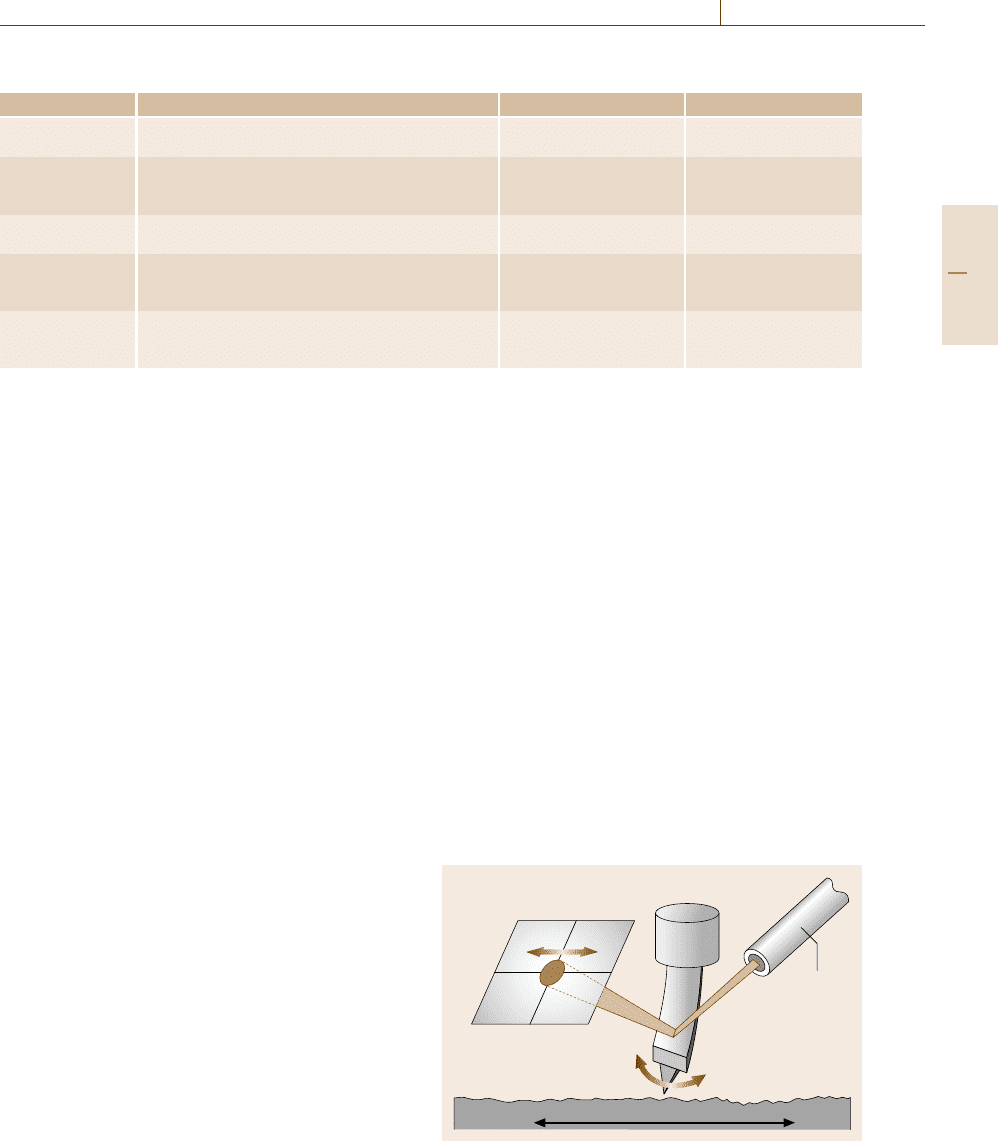
Friction and Wear 13.4 Friction Measurement 757
Table 13.2 Types of force standard machine
Type Principle Uncertainty attainable Category
Deadweight
machines
A known mass is suspended in the Earth’s gravita-
tional field and generates a force on the support
< 0.001% Primary or secondary
Hydraulic ampli-
fication machines
A small deadweight machine applies a force to
a piston-cylinder assembly and the pressure thus gen-
erated is applied to a larger piston-cylinder assembly
< 0.02% Secondary
Lever amplifica-
tion machines
A small deadweight machine with a set of levers
which amplify the force
< 0.02% Secondary
Strain-gauged
hydraulic
machines
The force applied to an instrument is reacted against
strain-gauged columns in the machine’s framework
< 0.05% Secondary
Reference force
transducer
machines
A force transfer standard is placed in series with the
instrument to be calibrated
< 0.05% Secondary
machines. Primary standards in force measurement are
machines whose uncertainty can be verified directly
through physical principles to the fundamental base
units of mass, length and time. Secondary standards can
be compared with primary standards through the use of
a force transfer standard, which is a calibrated force
transducer, frequently a strain gauge load cell. Stan-
dards document ISO 376 describes the calibration and
classification of transfer standards.
Table 13.2 lists types of force standard machines
that have been developed for the calibration of static
forces acting along a single well-defined axis. The prin-
ciples used for the calibration of multicomponent force
sensors remain the same, but cross-talk between the
different axes must also be considered. For the mea-
surement of dynamic forces it is assumed that the
statically-derived force transducer sensitivities are ap-
plicable, but attention must also be paid to the natural
frequencies of the load cell.
The calibration of a force transducer can be per-
formed with the transducer in its permanently installed
position by using a transfer standard, or prior to its
installation and by removal as required for further cali-
bration.
More information on force measurement and cali-
bration can be found elsewhere [13.14,15].
For very small forces, as measured with an atomic
force microscope (AFM), special calibration procedures
are needed. An AFM can be used to measure fric-
tion forces in the nN range. The calibration methods
used for this force-measuring machine also use known
masses under gravity, but the lowest attainable uncer-
tainty is much greater than that described above for
macroscopic forces. The AFM scans a probe tip over
the surface under examination. It operates like a sty-
lus profilometer with constant contact force, which is
maintained by steering the bending of the cantilever
beam carrying the probe tip using a piezoelectric el-
ement (Fig. 13.13). The bending of the cantilever is
sensed by a segmented photodiode which measures the
intensity of laser light reflected from the back of the
cantilever. The piezoelectric driving voltage is adjusted
during the scan over the surface to hold the resulting dif-
ference in photocurrent between segments (1+2) and
segments (3 +4) constant. A constant photocurrent im-
plies constant beam deflection, which is equivalent to
a constant force. The piezoelectric voltage needed to
hold the photocurrent constant is thus a measure of the
topographical height at the instantaneous position of the
tip. The height resolution of an AFM is in the range of
atomic dimensions.
If the direction of scanning is perpendicular to the
axis of the cantilever, the torsion of the cantilever pro-
vides a measure of the friction force between the tip and
the sample. The torsion is measured by the difference
between the photocurrents from segments (1+3) and
Segmented
photodiode
12
34
Piezo
Laser
Cantilever
Sample surface
AFM tip
Fig. 13.13 Principle of friction measurement with an AFM
(atomic force microscope)
Part D 13.4
